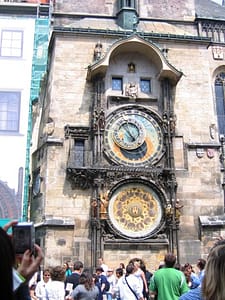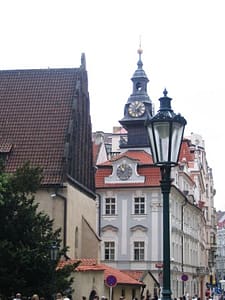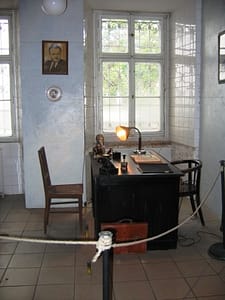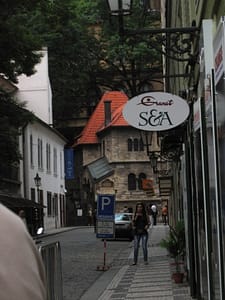Prague is a city where history whispers from every cobblestone, where the past and present intertwine in unexpected ways. On our self-guided (and somewhat ambitious) walking tour, we uncovered stories of wonder, tragedy, and irony in three unforgettable places: the Astronomical Clock, the Jewish Quarter, and the Museum of Communism.
 The Astronomical Clock: A Timepiece with a Dark Past
The Astronomical Clock: A Timepiece with a Dark Past
Nestled in Prague’s Old Town, the Astronomical Clock is an engineering marvel and a storyteller of its own. Just two blocks from our hotel, it was astounding to realize how far we had walked in our eager exploration.
Built in 1410 by clockmaker Mikuláš of Kadaň and astronomer Jan Šindel, the clock is renowned not only for its intricate design but also for the gruesome legend that accompanies it. As the story goes, the Prague council feared that the master clockmaker might replicate his masterpiece elsewhere. To ensure exclusivity, they gouged out his eyes, rendering him unable to create another. In his final act of defiance, he supposedly sabotaged his own work, stopping the clock for nearly a century.
At the foot of the clock, 27 crosses mark the site where noblemen were executed after the Battle of White Mountain in 1621. It’s said to bring bad luck to step on them. We made sure not to—out of respect more than superstition.
 The Jewish Quarter: A Haunting Legacy
The Jewish Quarter: A Haunting Legacy
No part of Prague stirred deeper emotion than the Jewish Quarter. Established in the 13th century as a ghetto, it confined Jewish residents for over 500 years before they were granted the right to live elsewhere. Walking its streets, we couldn’t escape the somber weight of history, especially knowing what lay ahead for Jewish families during World War II.
Time was against us, and we could only glimpse a fraction of its history. The Jewish Cemetery alone left a lasting impression—12,000 gravestones crammed into less than 2.5 acres, with the remains of over 100,000 souls layered up to 12 deep. It was a sight both haunting and humbling.
Next to the cemetery, we visited a museum displaying artwork by children from the Holocaust. Their drawings, frozen in time, carried the sorrow and fear of a generation lost. The weight of it stayed with us long after we left.

Reaching the Museum of Communism required walking through an unexpected gateway—McDonald’s. The irony wasn’t lost on us.
Inside, stark rooms displayed remnants of a regime that sought to suppress individualism—old typewriters, rigid wooden chairs, and artifacts of a controlled society. The contrast between the oppressive past and the bustling capitalist reality just outside its doors was striking.

Prague is a city of contradictions: beauty and brutality, triumph and tragedy, freedom and control. It’s a place where the past is never far from the present, reminding us to honor history’s lessons.
Have you ever been to Prague? What part of its history left the biggest impression on you? Share your thoughts in the comments below.